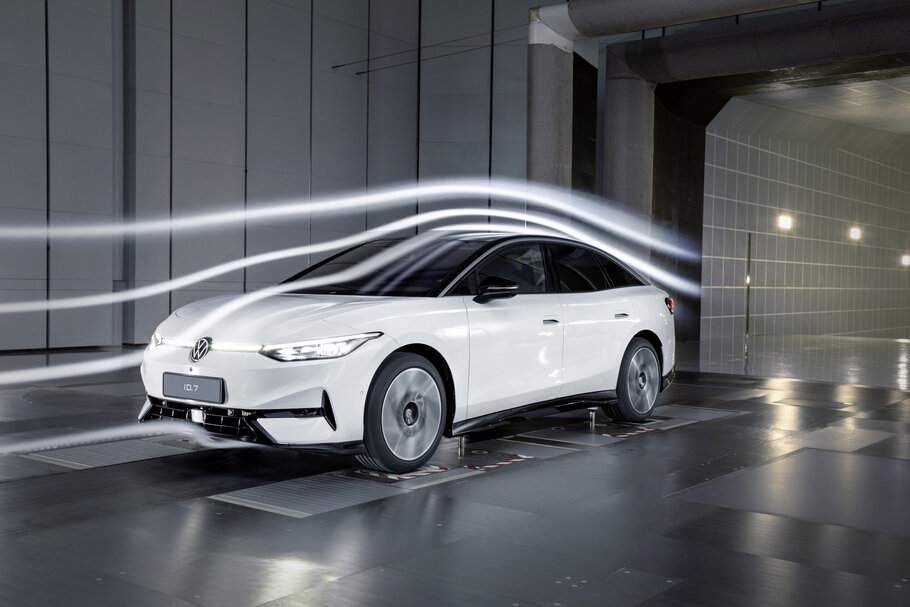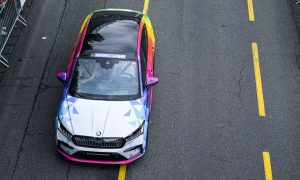
The ID.7 is the first electric model from Volkswagen for the upper mid-sized class. With a range of up to 700 kilometres (WLTP)2, the Volkswagen limousine is an efficiency champion. In addition to a new drive generation, sophisticated aerodynamics contribute to the ID.7’s long ranges. The aerodynamically favourable basic form, low drag coefficient (Cd value) of 0.23 and frontal area of 2.46 m2 are the result of close cooperation between the Design and Development departments.
With limousines like the ID.7, the body shape accounts for about 50 per cent of the Cd value. The wheels and tyres influence about 30 per cent, the underfloor 10 per cent, and the functional openings through which air flows to the radiators in the vehicle front end, for example, also 10 per cent. The fact that the new ID.7 is the most aerodynamic ID. model so far can be seen at first glance when looking at the silhouette of the vehicle, which is almost five metres long. Volkswagen designer Daniel Scharfschwerdt says: “When designing the ID.7, there was a greater focus on aerodynamics than for practically any other model. This can be seen in the low front end, the flowing transition into the bonnet, and the fast windscreen. The coupé-like roof form and the tapering rear end are also designed for ideal aerodynamic performance.”
Even in the early stages of product development, intensive work was carried out on the exterior design, as well as on the underbody, wheels and other fine details. The prerequisite for optimal results is close collaboration between developers and designers. Stephan Lansmann, project engineer responsible for ID.7 aerodynamics: “We strive for ideal solutions in an iterative process, which includes regular consultation between the Development and Design departments. There are many small steps here that pay off in the end. Numerous computer simulations for flow calculation are complemented by tests in a wind tunnel as part of this process.”
The aerodynamic strengths of the ID.7
The ID.7 has an almost completely closed underbody. This is supplemented by newly Developern wheel spoilers on the front wheels. These guide the air along the wheels under the vehicle with minimum turbulence. Air curtains at the sides of the front bumper direct the air around the vehicles front end with minimum loss. The flared side sills prevent the air from flowing into the underbody area and shield the rear tyres from air flowing onto them. In addition, small spoilers and trim panels guide the flow of air on the underbody.
“On electric vehicles, the wheels make a greater contribution to good aerodynamics, and we therefore focused on them in particular,” says Lansmann. “When designing the wheel rims, the primary focus was on the aerodynamics, which we also had to match to the cooling requirements of the brakes,” explains the expert. “The resultant wheel rims are more closed and therefore have especially good aerodynamic properties.” Flow simulations were also used when designing the tyre contours. This meant it was already possible to optimise variants with less good aerodynamic characteristics during the concept phase.
Other areas were also taken into account in the holistic aerodynamic development process. These include the functional openings at the front, for example, through which air flows to the radiators in the vehicle front end. In the ID.7, the air flow is actively controlled by a radiator roller blind in order to reduce the drag. The electrically operated roller blind opens only when targeted cooling of the power units and battery is required. At the rear, aerodynamic efficiency is ensured by the ideally shaped tailgate and the design of the diffuser and side separation edges.
From computer to wind tunnel
The initial focus is on computer simulations. “Work only takes place virtually in the first year of development, with updates about every two weeks,” says Lansmann. The design team supplies CAD (Computer-Aided Design) data. Several thousand processors then calculate the air flow values, also for numerous details like the flush-recessed door handles and the aerodynamically designed mirrors of the ID.7. “We go into the wind tunnel only when the design is stable. That can take a good one and a half years from the start of development,” says the development engineer.
The team used Volkswagen clay models in the original size of the ID.7 in the wind tunnel. The new findings are implemented on the model using a milling cutter with millimetre precision – for example, in the event of changes to the rear and to the separation edges. With the help of the prototype parts from the 3D printer, Stephan Lansmann’s team tested numerous variants – also for the aerodynamically shaped exterior mirrors, for example. On the ID.7, this process allowed them to optimise the upper and lower mirror housing sections and mirror base to achieve a lower drag coefficient with outstanding aerodynamic properties. The result of this detailed work is a Cd value of 0.23, the best drag coefficient of the entire Volkswagen ID. family.



